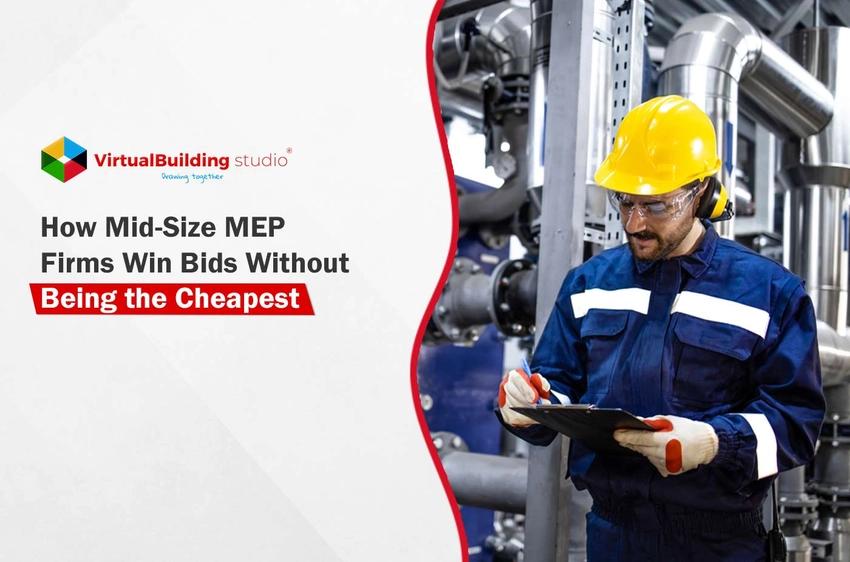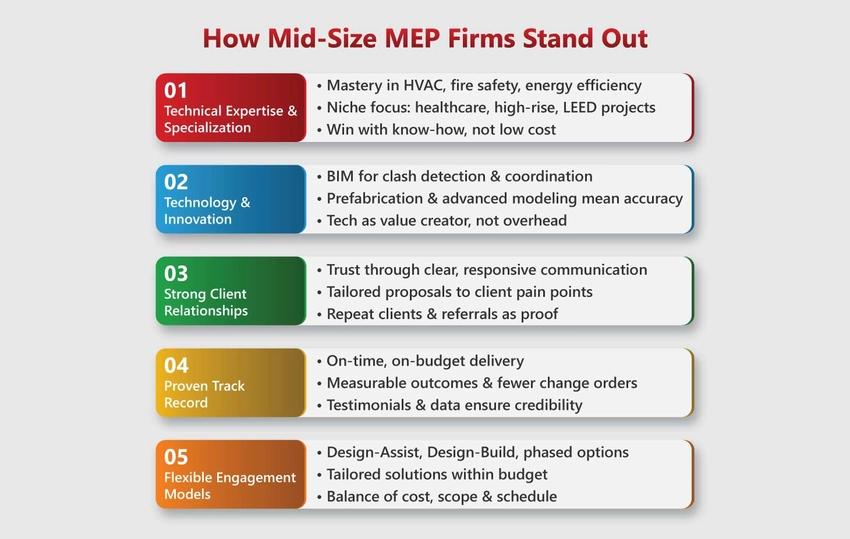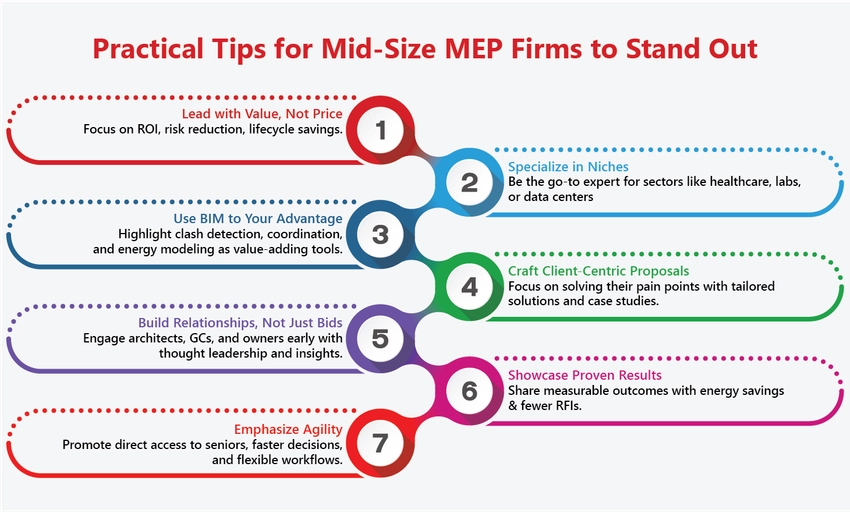
Breaking Free from the Commoditization Trap
Mechanical, electrical, and plumbing (MEP) services are often considered as commodities in the competitive construction industry of today. Price is the deciding factor in too many bids, trapping mid-size MEP companies in a cycle where cutting expenses seems to be the only way to stay in business.
However, this approach generates an unavoidable challenge.
- Large MEP firms tend to dominate bids due to extensive resources, well-known brands, and the ability to manage large-scale projects.
- Despite possible concerns, smaller MEP businesses draw in cost-conscious customers by undercutting with extremely low prices.
Mid-size businesses often find it difficult to establish their value in between. However, companies that do not just compete on price are the ones that generally secure lucrative, long-term projects.
Value differentiation is an important aspect that demonstrates to clients why technical knowledge, innovation, and proven reliability are more important than nominal cost savings.
In this article, we will explain five strategic approaches that can help mid-size MEP firms to win bids by changing client focus from cost to value.
The Competitive Edge for Bidding on MEP
The bidding procedure is not at all simple for mid-size MEP contractors. They work in an uncertain middle ground where strategic placement, not size or lowest cost, determines survival.
There are two difficulties:
- Large MEP Firms: They control high-value projects because of their well-known brands, large workforce, and risk-taking capacity. Even when mid-size athletes contribute similar technical expertise, their presence frequently overshadows them.
- Small MEP Businesses: They can offer aggressive pricing because of their lean operations. Price-sensitive customers could be tempted, but these businesses frequently have trouble with accuracy, scalability, and fulfilling deadlines.
Client expectations are changing with time. Nowadays, winning projects requires more than just following the rules:
- Drawing accuracy to reduce conflicts and rework.
- Delivery efficiency to fulfill shortened project deadlines.
- Sustainability must comply with energy codes and green building requirements.
- Improved coordination, fewer change orders, and dependable execution to reduce risk.
Differentiation beyond price is not at all optional in this industry; rather, it is necessary. Mid-size businesses get a competitive edge by underscoring their proficiency in technology, tailored workflows, and proven outcomes. Hence, they can represent themselves as valued partners that offer both affordability and long-term loyalty rather than being forced out.
Top 5 Strategies for Winning Bids Without Being the Cheapest
Reframing the value equation is how mid-size MEP firms win projects, not cutting fees. The five tactics listed below can assist in converting cost-driven discussions into collaborations that add value.
The Foundation: Reframing the Conversation from Cost to Value
You need to change the client's perspective before even sharing the RFP (Request for Proposal). While making decisions, consider risk and trustworthiness as more important aspects than price alone.
The Real Fear of the Client
Customers don’t just buy design drawings; in fact, they are purchasing insurance against operational inefficiencies, expensive RFIs, delays, and budget overruns. A successful bid needs to immediately allay these anxieties.
The Value Language
Do not represent your company as the "cheapest." Rather, say:
- "We provide the best value over the long run."
- "We reduce project risk."
- "We maximize lifecycle expenses."
The Cost of Ownership Argument
Construction efficiency, lower energy use, less maintenance, and fewer change orders readily cover a little higher design charge. This narrative gives you more assurance that your higher fee will ultimately result in cost savings.
The Pre-Bid Approach: Winning Before You Write a Proposal
The most competent mid-size businesses are aware that the work completed before the proposal usually dictates the final result.
Specialization in a niche
You cannot rule every industry. Rather, establish yourself as an expert in two or three verticals, like:
- Mission-critical data centers
- Labs and healthcare with stringent compliance requirements
- Historic retrofits that need careful utility integration
- Being specialized makes you a "go-to partner" rather than a "generic provider."
Relationship-Based Business Development
Establish credibility well in advance of the bidding. Distribute free resources, such as webinars on updated energy codes, white papers on new ASHRAE standards, or fast project health audits. By doing this, your company is positioned as a knowledge partner rather than merely a supplier.
Opportunities to Pre-Qualify
Not every bid is worthwhile. If procurement is solely motivated by cost and disregards your worth, then choosing not to bid could free up funds for profitable, winnable ventures. Winning requires smart decision-making, not always submitting.
Beyond the Standard Proposal: Making the Proposal a Strategic Tool
A proposal is meant to be a tactical selling tool, not merely a form. The successful firms know how to convert a document to a compelling story.
Don’t Just Provide Your Service List; Tell the Story
Your listing of services interests your clients little. Structure your proposal around the clients’ goals. Here’s an executive summary that could demonstrate that:
Don’t just provide statements; provide evidence
- Case Studies: Provide two to three case studies with actionable results. For example: “BIM sequencing reduced construction schedule by four weeks on a high-rise,” and “Renovating a hospital generated a 25% reduction in HVAC energy use.”
- Introduce Team: Emphasize directly relevant experience in your team rewrites to reinforce trust in the conveyed team having dealt with similar issues.
- The Value-Added Section: Make sure to clearly articulate deliverables that your competitors may overlook:
- Energy modeling in-house at no additional fee.
- Anticipating clashes in the design using Autodesk BIM 360 Model Coordination and our proprietary Dynamo scripts.
- Minimizing RFIs during construction with dedicated QA/QC workflows.
This reframes the proposal from a price proposal to a roadmap for eliminating risk and adding value.
The Interview: Concluding the Deal with Clarity and Confidence
The goal of the interview stage is to establish trust and show that you are prepared, not just here to repeat your slides.
The A-Team Approach
Instead of bringing in business developers, bring in the project manager, lead engineer, and QA/QC head. This demonstrates genuineness and offers clients assurance in the people they will collaborate with on a daily basis.
Pay Attention to The Process
Explain to the client how you will work together:
- The frequency of your coordination meetings
- Protocols for communication
- Workflow examples for submissions that avoid bottlenecks
Deal with the Unspoken Issue
Don't be afraid to talk about fees. Acknowledging that your pricing may be greater, you can say,
When conducted well, the interview turns into a trust-conversion event.

Using Agility as a Selling Point: Maximize Your Mid-Size Advantage
Being mid-sized is a strategic asset rather than a drawback.
Direct Access vs. Bureaucracy
Clients communicate with senior engineers and principals directly, which facilitates better innovation and quicker decision-making.
Flexibility and Cooperation
You are more technically sophisticated than small, low-cost stores and more flexible than large MEP firms. You can give speed, quality, and adaptability in ways that rivals cannot because of this balance.
Leveraging their unique position, being both small enough to be responsive and large enough to handle complexity, allows mid-size businesses to succeed.

Why Clients Often Choose Value Over Lower Price
The lowest bid rarely translates into the lowest cost in MEP projects. Customers who only consider pricing frequently run the danger of unintended consequences, such as:
- Reworking designs that are error-prone or incomplete
- RFIs and poor coordination resulted in delays.
- Low quality that raises lifecycle costs by requiring more maintenance and energy
Long-term ROI is becoming more important to forward-thinking owners and contractors. They are looking for designs that:
- Boost code compliance and sustainability
- Reduce the risks and change orders associated with construction
- Provide dependable service for decades, not just while building
Mid-size MEP companies are excellent in this area. They mix deep expertise, cutting-edge solutions like BIM-enabled MEP coordination, agile procedures, and affordability. They portray themselves as the wise, risk-free alternative to both resource-intensive giants and low-cost service providers by striking a balance between cost-effectiveness and technical competence.
Conclusion
A strategic focus on value is necessary to win bids without competing only on price. The combination of technical competence, creative workflows, trustworthy customer connections, and a track record of success is what makes mid-size MEP firms successful. Instead of undercutting rates, they show tangible advantages that appeal to clients looking for long-term results, such as risk reduction, lifetime cost reductions, and dependable project execution.
Mid-size businesses are in a special position because they are both big enough to manage intricate projects using cutting-edge technologies like BIM and flexible enough to provide individualized attention and quick decision-making. Their specialty, adaptability, and quality enable them to regularly secure lucrative projects without sacrificing standards.
It's time for MEP firms to reconsider their approach if they want to increase the success of their bids.
